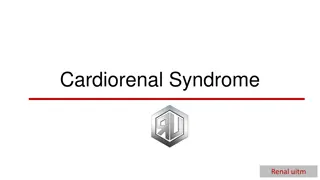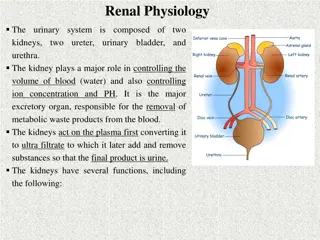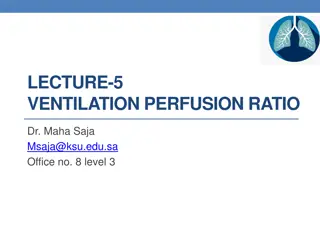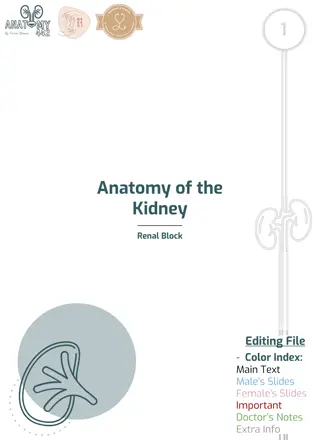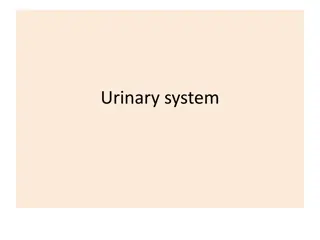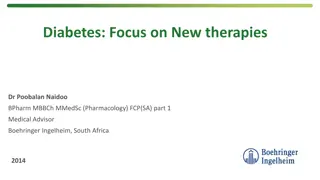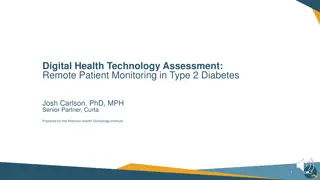Microvascular Perfusion Loss in Kidneys of Children with Type 1 Diabetes
Dynamic tissue perfusion measurement using PixelFlux reveals microvascular perfusion loss in the kidneys of children with type 1 diabetes. This study examines the impact of diabetes duration, A1C levels, dyslipidemia, and blood pressure on renal microvessel disease. PixelFlux, a color Doppler ultrasound method, provides insights into cortical perfusion and offers a standardized approach to measuring perfusion intensity. The research highlights the importance of early detection and monitoring of microvascular complications in pediatric diabetes patients.
Download Presentation

Please find below an Image/Link to download the presentation.
The content on the website is provided AS IS for your information and personal use only. It may not be sold, licensed, or shared on other websites without obtaining consent from the author. Download presentation by click this link. If you encounter any issues during the download, it is possible that the publisher has removed the file from their server.
E N D
Presentation Transcript
DYNAMIC TISSUE PERFUSION MEASUREMENT REVEALS MICROVASCULAR PERFUSION LOSS IN KIDNEYS OF CHILDREN WITH DIABETES MELLITUS TYPE 1 Thomas Scholbach, Christian Vogel, Nils Bergner Pediatric Hospital, Chemnitz Clinics, Chemnitz, Germany t.scholbach@skc.de
Background Diabetes mellitus type 1 (DM1) Increasing incidence Earlier onset Risk for microvascular damage Retina Kidney Risk factors Diabetes duration, A1C, dyslipidemia, blood pressure, and male sex
Renal microvessel disease in DM1 Onset years after DM1 manifesation Development in ~30% of the DM1 population No predictive parameters? glomerular hyperfiltration After calculated diabetes duration of 40 years 25.4% microalbuminuria 9.4% macroalbuminuria or ESRD Raile, K., et al. (2007). Diabetes Care 30(10): 2523-2528
What is PixelFlux? The first method to measure tissue perfusion intensities by color Doppler ultrasound Dynamic Tissue Perfusion Measurement all vessels entire area complete heart cycle
Material and Methods 93 children with diabetes type 1 4 18 years No microalbuminuria 71 healthy age matched children Parameters Duration of DM, age of onset, Insulin dose, Creatinine, blood pressure, Color Doppler ultrasound PixelFlux measurements of cortical perfusion
How does PixelFlux work? Standardized ultrasound preset Standardized organ sections Standardized ROIs Standardized sub-ROIs Calibrated color hues Calibrated distances Calculation of ROI-specific Perfusion Intensity PI = v * A/AROI
Old : RI New: PixelFlux D50 P50 Single vessel No matter which amount of blood All vessels Perfused area Perfusion velocity Normal RI despite renal failure with creatinine at 800 mol/l
Old : RI New: PixelFlux D50 P50 RI 0,68 Creatinine 70 mol/l D50 P50 RI 0,61 Creatinine 230 mol/l Misleading normal RI despite different tissue perfusion
What the naked eye can see: What the naked eye can see Nothing really reliable !! Diabetes systolic normal systolic normal systolic normal diastolic Diabetes diastolic Diabetes diastolic
Microvascular damage in a diabetic kidney in an adult without signs of diabetic nephropathy
PixelFlux measurements in pediatric diabetic patients Normal Diabetes Proximal cortex: p50 Distal cortex: d50 Stratified sub-ROIs - useful in kidneys
p = 0,006 p < 0,001
p < 0,001 p = 0,001 p = 0,015 p < 0,001 p < 0,001
Tissue Resistance Index Pulsation of all vessels within the ROI Pulsating parameters may be Intensity Velocity Area TRI = sysall vessels diaall vessels/sysall vessels
Significant correlation of TRIintensity and duration of diabetes type 1 TRIintensity r 0,260 0,012 p N 93 duration of diabetes type 1 (a)
Significant correlation of TRIintensity and systolic blood pressure TRIintensity r 0,237 0,022 p N 93 Systolic blood pressure (Torr)
Significant correlation of TRIintensity and Insulin dose TRIintensity r 0,268 0,009 p N 93 Insulin dose (U/kg)
Significant correlation of TRIintensity and serum creatinine TRIintensity r 0,230 0,028 p N 93 Serum creatinine ( mol/l)
Conclusion PixelFlux measurements detect diabetic renal microvessel damage before it becomes functionally or clinically manifest Correlate to clinical and laboratory parameters in diabetes Larger and Dm2 studies are necessary Invitation for joint studies t.scholbach@skc.de



